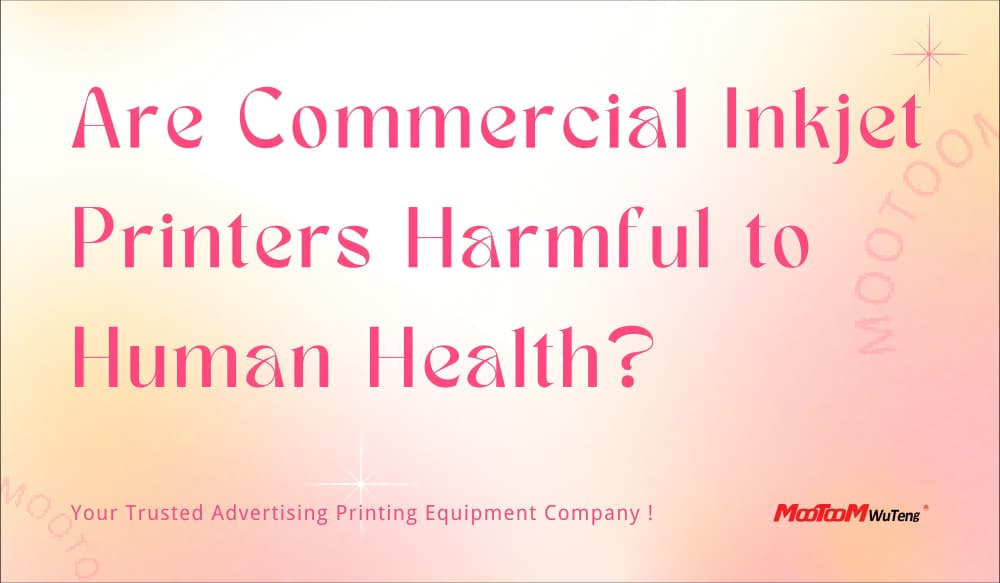
Are Commercial Inkjet Printer Harmful to Human Health?
As the use of commercial inkjet printer becomes more widespread in businesses and industries, an important question arises: Are these printers harmful to human health? While inkjet printers are common in both home and professional settings, concerns have been raised regarding the potential health risks associated with their operation, especially when used on a large scale. Let’s explore the potential health impacts of commercial inkjet printers and how businesses can ensure safe use.
Ink Components and Health Concerns
The main problem associated with commercial inkjet printer is the ink they use. Inkjet inks typically contain a mixture of pigments or dyes, solvents and additives. Some of the potential health risks associated with printer ink components include:
Volatile Organic Compounds (VOCS): Some inks may contain VOCs that evaporate into the air during the printing process. Prolonged exposure to high levels of VOCs can cause irritation of the eyes, nose and throat, as well as headaches and dizziness. In poorly ventilated areas, higher concentrations of VOCs may pose more serious health risks over time.
Heavy Metals: Some ink formulations may contain small amounts of heavy metals such as lead or cadmium. While modern inkjet ink formulations often minimise these harmful elements, older or cheaper inks may pose a risk if inhaled or absorbed through the skin.
Aerosols: Commercial inkjet printers, especially high-capacity models, can release tiny particles into the air called aerosols. These tiny ink droplets can be inhaled and may cause respiratory irritation in sensitive individuals.
Ozone Emission and Indoor Air Quality
While laser printers are more likely to produce ozone emissions due to their reliance on high-pressure systems, commercial inkjet printers can still affect indoor air quality. Over time, dust, paper dust and chemicals can build up in the environment, causing problems for workers in poorly ventilated spaces. Maintaining good air circulation and ensuring that printers are used in well-ventilated rooms can help alleviate this concern.
Skin and Eye Irritation
Direct contact with ink, either by handling the cartridge or cleaning the printer, can cause skin irritation. Commercial inkjet inks may contain chemicals that cause minor irritation when they come into contact with the skin, but serious reactions are rare. Ink particles may irritate the eyes if they inadvertently get into the eyes.
To reduce the risk of irritation:
- Employees handling ink should wear protective gloves.
- Cartridges and printheads should be handled according to manufacturer guidelines.
Long-Term Health Risks: What the Research Says
Currently, there is no strong evidence that the use of commercial inkjet printers is associated with significant long-term health risks (e.g., cancer or chronic respiratory disease). However, studies of printer emissions tend to focus more on laser printers than on inkjet printers. Nonetheless, regulatory agencies such as OSHA and EPA have indicated that the health risks associated with modern inkjet printers are generally low if the equipment is used properly and maintained in well-ventilated spaces.
Mitigating Potential Health Risks
While commercial inkjet printers are generally safe, businesses can take steps to further minimize any health risks for employees:
Ensure Proper Ventilation: Regularly ventilate the space where the printer is used to reduce the build-up of VOCs, aerosols, and other airborne particles.
Use High-Quality, Certified Inks: Choose cartridges that meet safety standards and are free of harmful chemicals. Many ink manufacturers now produce eco-friendly inks with lower levels of volatile organic compounds and heavy metals.
Implement Safe Handling Practices:Provide employees with appropriate protective equipment (e.g., gloves) when handling ink or performing maintenance on the printer. This helps to minimise direct contact with the ink.
Schedule Regular Maintenance: Regular printer maintenance ensures that machines run efficiently and minimises the release of particles or chemicals into the air.
Conclusion
Commercial inkjet printers are generally safe to use and pose minimal health risks when operated correctly under appropriate conditions. Critical issues such as VOC emissions, ink exposure and indoor air quality can be effectively managed through correct handling practices, good ventilation and the use of high quality inks. By taking these precautions, organisations can use commercial inkjet printers with confidence without compromising the health and safety of their employees.

Search the Blog
CONTACT US AT ANY TIME
If you have any questions, suggestions or are interested in working with us, please feel free to contact us !



1.jpg)


